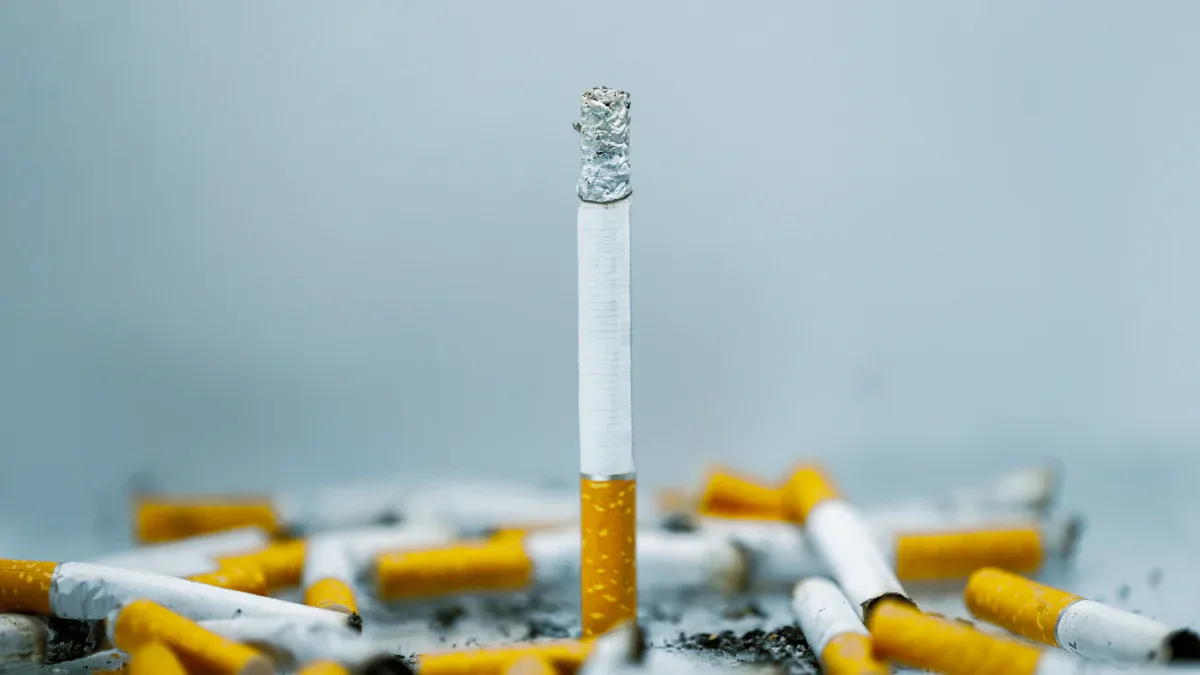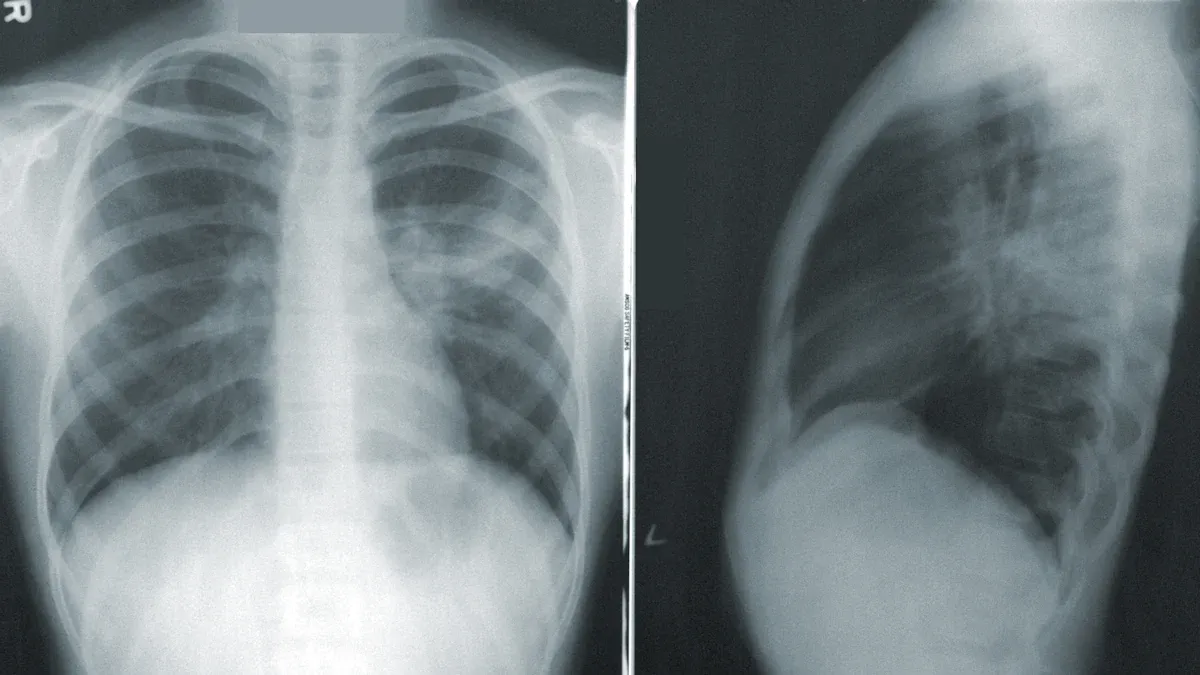What Causes Adenocarcinoma of the Lung and Its Risk Factors

Adenocarcinoma of the lung is the most common type of lung cancer, accounting for over 30% of all cases worldwide. It also represents nearly 40% of non-small cell lung cancers (NSCLC). Smoking remains the leading cause, contributing to about 80% of lung cancer deaths. However, other factors like exposure to radon, secondhand smoke, and hazardous chemicals such as asbestos and chromium also play a role. Uncontrollable risks, including air pollution and genetic mutations, further increase susceptibility. Understanding these causes empowers you to take steps toward prevention and early detection.
Key Takeaways
Smoking is the main cause of lung adenocarcinoma. Stopping smoking can greatly reduce your risk.
Radon gas is a big risk factor. Check your home for radon and fix it if levels are over 4 pCi/L.
Your genes can raise your risk. If lung cancer runs in your family, think about genetic counseling for early checks.
Avoid harmful chemicals at work and home. Wear safety gear and follow rules to keep your lungs safe.
Eating healthy food and exercising often can lower cancer risk and make you healthier overall.
Causes of Adenocarcinoma of the Lung

Smoking and Secondhand Smoke
Smoking remains the primary cause of adenocarcinoma of the lung. It damages the cells lining your lungs, leading to mutations that can develop into cancer. This type of lung cancer originates in mucus-secreting glands, making it particularly linked to smoking. About 80% of lung cancer deaths are attributed to smoking, underscoring its significant role.
Secondhand smoke also increases your risk. It contains many of the same cancer-causing agents as direct tobacco smoke. When you inhale secondhand smoke, you expose yourself to harmful substances that can damage your lung tissue over time. Even if you don’t smoke, frequent exposure to secondhand smoke can elevate your chances of developing adenocarcinoma of the lung.
Radon Exposure
Radon, a naturally occurring radioactive gas, is another major contributor to lung cancer. It seeps into homes through cracks in floors and walls, often going unnoticed. Prolonged exposure to high radon levels can damage your lung cells, increasing the likelihood of cancer.
Studies show that radon exposure causes approximately 21,000 lung cancer deaths annually in the U.S., with about 2,900 of these occurring in non-smokers. The risk becomes significant when radon levels exceed 4 pCi/L. The CDC and Surgeon General recommend fixing your home if levels surpass this threshold.
Radon Level | Lifetime Risk of Lung Cancer | Recommended Action |
|---|---|---|
20 pCi/L | About 36 people could get lung cancer | Fix your home |
10 pCi/L | About 18 people could get lung cancer | Fix your home |
4 pCi/L | About 7 people could get lung cancer | Fix your home |
3 pCi/L | Recommended remediation by WHO | Fix your home |
2 pCi/L | About 4 people could get lung cancer | Consider fixing between 2 and 4 pCi/L |
1.3 pCi/L | About 2 people could get lung cancer | Reducing levels below 2 pCi/L is difficult |
Genetic Predisposition
Your genetic makeup can also influence your risk of developing adenocarcinoma of the lung. Certain gene mutations, such as EGFR, KRAS, and TP53, are commonly associated with this type of cancer. These mutations can disrupt normal cell growth, leading to uncontrolled division and tumor formation.
Some mutations, like ALK and ROS1, are more prevalent in non-smokers. Others, such as HER2, are more common in women. If you have a family history of lung cancer, you may carry genetic mutations that increase your susceptibility. Understanding your genetic risk can help you take preventive measures and seek early screening.
Environmental and Occupational Hazards
Your environment and workplace can significantly impact your risk of developing adenocarcinoma of the lung. Prolonged exposure to harmful substances like asbestos, diesel exhaust, and chromium compounds can damage your lung tissue. These substances are often found in industries such as construction, mining, and manufacturing. If you work in these fields, you may face a higher risk of inhaling carcinogens daily.
Air pollution also plays a role. Pollutants like soot, tar, and fine particulate matter can irritate your lungs and increase cancer risk. Urban areas with heavy traffic and industrial emissions often have higher pollution levels. Breathing in these toxins over time can lead to cellular changes in your lungs.
Radon exposure, though naturally occurring, is another environmental hazard. It seeps into homes and buildings, especially in areas with poor ventilation. Testing your home for radon and taking steps to reduce its levels can help protect your lungs.
Occupational hazards are preventable. Wearing protective gear, following safety protocols, and minimizing exposure to hazardous substances can reduce your risk. If you suspect exposure to harmful chemicals, consult your employer or a health professional for guidance.
Other Contributing Factors
Several other factors may contribute to adenocarcinoma of the lung. These include lifestyle choices, infections, and even certain supplements. For example:
Drinking water with high arsenic levels can increase your risk.
Having HIV weakens your immune system, making you more vulnerable to cancer.
Taking beta carotene supplements while smoking may raise your chances of developing lung cancer.
Emerging research highlights additional risks. Previous radiation therapy, especially to the chest, can damage lung tissue. A personal or family history of lung cancer may also indicate a genetic predisposition. Air pollution remains a growing concern, particularly in densely populated areas.
Understanding these factors allows you to make informed decisions about your health. Avoiding unnecessary risks and seeking regular medical check-ups can help you stay proactive in preventing adenocarcinoma of the lung.
Risk Factors for Adenocarcinoma of the Lung

Lifestyle Choices
Your lifestyle choices can significantly influence your risk of developing adenocarcinoma of the lung. Smoking is the most well-known factor, but other habits also play a role. A poor diet and lack of exercise can increase your vulnerability. Research by Dr. Marisa Bittoni shows that healthier diets and regular exercise can reduce cancer mortality by 40-50%. Exercise, in particular, helps block tumor growth and reduces inflammation, which is linked to cancer development. By adopting a balanced diet and staying active, you can lower your risk and improve your overall health.
Family History and Genetics
Your genetic makeup can predispose you to adenocarcinoma of the lung. If you have a family history of lung cancer, you may carry specific genetic mutations that increase your risk. These mutations include changes to chromosome 6 and alterations in genes like EGFR, KRAS, and TP53. Other markers, such as ALK, BRAF, and STK11, are also associated with this type of cancer. Understanding your genetic risk can help you take preventive measures, such as early screening and lifestyle adjustments.
Tip: If you have a family history of lung cancer, consider genetic counseling to assess your risk and explore preventive strategies.
Exposure to Carcinogens
Daily exposure to carcinogens can damage your lung tissue and increase your risk of adenocarcinoma of the lung. Common carcinogens include tobacco smoke, asbestos, diesel exhaust, and outdoor air pollution. Even substances like formaldehyde and arsenic in drinking water can contribute to cancer development.
Here are some of the most common carcinogens:
Tobacco smoke
Asbestos
Diesel engine exhaust
Outdoor air pollution
Arsenic and inorganic arsenic compounds
Alcoholic beverages
Reducing your exposure to these substances can protect your lungs. For example, avoid smoking areas, wear protective gear if you work with hazardous materials, and test your home for radon.
Demographic and Health Factors
Your age, gender, and overall health can influence your risk of developing adenocarcinoma of the lung. Women, for example, are diagnosed with this type of lung cancer more often than men. Interestingly, more than two-thirds of nonsmokers with lung cancer are women, and most of these cases involve adenocarcinoma. Recent trends also show a rise in lung cancer among younger women, making it a growing concern for this demographic.
Adenocarcinoma is not limited to older adults. It is increasingly prevalent among individuals under 45 years old. This highlights the importance of awareness and early detection, even for younger populations. If you fall into these groups, staying informed and proactive about your lung health is essential.
Pre-existing health conditions can also play a role. Chronic obstructive pulmonary disease (COPD), for instance, significantly increases your likelihood of developing adenocarcinoma of the lung. Studies reveal that individuals with COPD are more likely to be diagnosed with early-stage lung cancer compared to those without the condition. Specifically, 22.7% of COPD patients receive an early-stage diagnosis, compared to 18% of individuals without COPD. This connection underscores the importance of managing chronic respiratory conditions and seeking regular medical evaluations.
Your health history matters. If you have COPD or other lung-related conditions, you should monitor your symptoms closely and consult your doctor about screening options. Early detection can improve outcomes and provide more treatment options.
By understanding how demographic and health factors affect your risk, you can take steps to protect yourself. Whether through regular check-ups, lifestyle changes, or increased awareness, you have the power to prioritize your lung health.
How to Reduce Your Risk
Quit Smoking and Avoid Secondhand Smoke
Quitting smoking is one of the most effective ways to lower your risk of adenocarcinoma of the lung. Smoking damages your lung cells, leading to mutations that can cause cancer. Even if you have smoked for years, stopping now can significantly reduce your risk. Consult a healthcare professional to explore quitting strategies, such as nicotine replacement therapies, medications, or support groups. These resources can make the process easier and increase your chances of success.
Avoiding secondhand smoke is equally important. Exposure to secondhand smoke introduces harmful chemicals into your lungs, even if you don’t smoke. Create a smoke-free environment at home and avoid places where smoking is allowed. By taking these steps, you protect yourself and those around you from the dangers of tobacco smoke.
Test and Mitigate Radon Levels
Radon is a silent threat that can increase your risk of lung cancer. Testing your home for radon is essential, especially if you live in an area prone to high radon levels. The ANSI/AARST MAH-2023 standard provides guidelines for accurate radon testing.
To ensure reliable results:
Place the test in undisturbed areas.
Keep it at least 3 feet from doors and windows.
Position it 20 inches to 6 feet from the floor.
Maintain closed-house conditions for at least 12 hours before testing.
Avoid testing during severe weather conditions.
If radon levels exceed 4 pCi/L, take action to mitigate them. Installing a radon reduction system can lower levels and protect your lungs from prolonged exposure.
Minimize Exposure to Hazardous Substances
Reducing your exposure to hazardous substances at work and home can help protect your lungs. Many workplaces contain carcinogens like asbestos, diesel exhaust, and formaldehyde. Following safety measures can minimize your risk.
Safety Measure | Description |
|---|---|
Personal Protective Equipment (PPE) | Always wear appropriate PPE, including gloves, masks, and protective clothing. |
Adherence to Safety Guidelines | Follow workplace safety guidelines established by OSHA to ensure a safer working environment. |
Ongoing Training | Participate in training sessions to stay updated on safe handling and disposal of hazardous materials. |
Use of Masks/Respirators | In environments with airborne particles, wearing masks or respirators is essential to reduce inhalation. |
At home, avoid using products with harmful chemicals and ensure proper ventilation. By taking these precautions, you can reduce your exposure to substances that may contribute to lung cancer.
Adopt a Healthy Lifestyle
Adopting a healthy lifestyle can significantly lower your risk of developing adenocarcinoma of the lung. A balanced diet and regular physical activity play key roles in maintaining lung health and overall well-being. By making thoughtful choices, you can strengthen your body’s defenses against cancer.
A healthy diet provides essential nutrients that support your immune system and reduce inflammation. Focus on eating a variety of fruits, vegetables, whole grains, and lean proteins. These foods contain antioxidants and other compounds that protect your cells from damage. Avoid processed foods and sugary drinks, as they can contribute to weight gain and inflammation.
Exercise is equally important. It helps your body function optimally and reduces cancer risk in several ways:
Research shows that healthier diets and regular exercise can decrease cancer mortality by 40-50%.
Physical activity reduces inflammation, which is linked to cancer development.
Exercise may also influence the microbiome and block cancer at a cellular level.
Even small changes can make a big difference. Start with activities you enjoy, like walking, swimming, or yoga. Aim for at least 30 minutes of moderate exercise most days of the week. Consistency matters more than intensity.
Other lifestyle habits also affect your lung health. Limit alcohol consumption, as excessive drinking can weaken your immune system. Stay hydrated by drinking plenty of water throughout the day. Prioritize sleep to allow your body to repair and regenerate.
By adopting these habits, you take proactive steps to protect your lungs and improve your quality of life. A healthy lifestyle not only reduces your risk of adenocarcinoma of the lung but also enhances your overall health and energy levels.
Adenocarcinoma of the lung develops due to both preventable and non-preventable factors. Smoking remains the leading cause, but exposure to radon, secondhand smoke, and hazardous chemicals also increases your risk. Even non-smokers face risks from air pollution and genetic predispositions. You can take proactive steps to protect your lungs by addressing modifiable risks. Quitting smoking, testing for radon, and avoiding carcinogens are effective strategies. Regular medical check-ups and early screenings further enhance prevention. Prioritize your lung health and consult healthcare professionals for personalized advice.
Tip: Resources for quitting smoking are widely available through health organizations.
FAQ
What is adenocarcinoma of the lung?
Adenocarcinoma of the lung is a type of non-small cell lung cancer. It begins in the mucus-producing glands of the lungs. This cancer is the most common form of lung cancer, especially among non-smokers and women.
Can non-smokers develop adenocarcinoma of the lung?
Yes, non-smokers can develop this cancer. Factors like radon exposure, air pollution, genetic mutations, and occupational hazards contribute to its development. Women and younger individuals are more likely to be diagnosed with adenocarcinoma despite not smoking.
How does radon exposure increase lung cancer risk?
Radon is a radioactive gas that seeps into homes through cracks. Prolonged exposure damages lung cells, increasing cancer risk. Testing and mitigating radon levels in your home can reduce this risk.
Tip: Use a radon test kit to check your home’s radon levels and take action if they exceed 4 pCi/L.
Is adenocarcinoma of the lung preventable?
You can reduce your risk by avoiding smoking, testing for radon, and minimizing exposure to carcinogens. Adopting a healthy lifestyle with regular exercise and a balanced diet also helps. However, genetic factors may still play a role.
When should you see a doctor for lung cancer screening?
You should consult a doctor if you have a family history of lung cancer, smoke, or experience symptoms like persistent cough, chest pain, or unexplained weight loss. Early screening improves treatment outcomes.
Note: Regular check-ups are essential, especially if you belong to high-risk groups.
ℹ️ Explore more: Read our Comprehensive Guide to All Known Cancer Types for symptoms, causes, and treatments.
#BanishCancer
